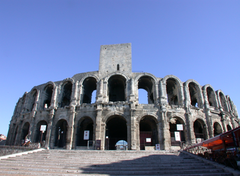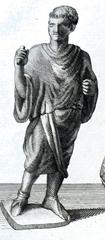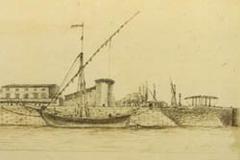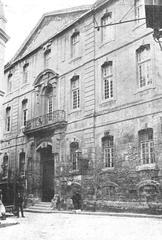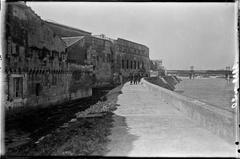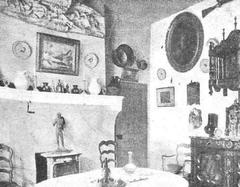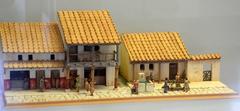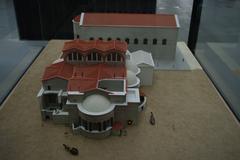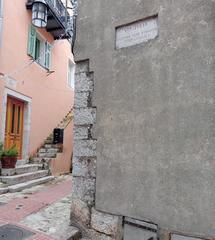Arles Rhône 3 Visiting Hours, Tickets, and Historical Sites Guide
Date: 14/06/2025
Introduction: Unveiling Arles Rhône 3 and Its Significance
On the banks of the Rhône River in southern France lies Arles—a city whose Roman past is vibrantly reflected in its grand monuments and archaeological discoveries. Among its most remarkable finds is the Arles Rhône 3, an exceptionally well-preserved 1st-century CE Roman river barge. Discovered submerged in the Rhône near Arles, this vessel provides an unparalleled window into Roman shipbuilding, commerce, and daily life in one of Gaul’s most important trade centers. Today, the barge is the centerpiece of the Musée Départemental Arles Antique, offering a captivating journey through history for all visitors (Musée Départemental Arles Antique; Perfectly Provence; On The Rhone).
This comprehensive guide will help you plan your visit to Arles Rhône 3 and the city’s other historic sites, with detailed information on opening hours, tickets, accessibility, guided tours, and practical tips for an enriching experience.
Table of Contents
- Introduction
- Discovery and Archaeological Significance of Arles Rhône 3
- Historical and Cultural Context
- Visiting Information
- The Museum Experience
- Nearby Attractions and Cultural Events
- FAQ
- Conclusion and Visitor Resources
Discovery and Archaeological Significance of Arles Rhône 3
Underwater Archaeology and Excavation
The discovery of Arles Rhône 3 in 2004 was the result of decades of systematic underwater exploration in the Rhône’s riverbed (Wikipedia; archeologie.culture.gouv.fr). Located just a few meters below the surface, the 31-meter-long, flat-bottomed oak vessel was found almost intact. Its extraordinary preservation was due to oxygen-poor sediments that shielded it from decay.
Excavating the barge required a complex, multi-year operation. Archaeologists carefully documented every timber and artifact before extracting and transporting the vessel to the Musée Départemental Arles Antique for conservation. The process included advanced treatments (such as PEG) to stabilize the ancient wood, and 3D digital documentation, setting a new standard for underwater archaeology (Academia.edu).
Insights into Roman Riverine Trade
Arles Rhône 3’s design—sturdy, flat-bottomed, and well-adapted to the Rhône’s currents—demonstrates the engineering prowess of Roman shipwrights (ontherhone.com). The cargo, which included amphorae, millstones, and daily-use objects, attests to Arles’ critical role as a trading hub linking the Mediterranean to inland Europe. Painted inscriptions and organic remains provide rare evidence of logistics, cargo labeling, and the work of Roman boatmen (archeologie.culture.gouv.fr).
Construction Techniques and Finds
Detailed study of the vessel reveals sophisticated woodworking—iron nails and wooden dowels fastened thick oak planks, while caulking and votive coins placed in the hull speak to the spiritual beliefs of ancient mariners (Capsur le Rhône). Numerous artifacts, from tools to anchors, enrich our understanding of river navigation and the lives of those who worked the Rhône.
Historical and Cultural Context
Roman Arles and the Rhône
Founded in 49 BC by Julius Caesar, Arles—then Arelate—flourished as a Roman colony (ontherhone.com). Its location on the Rhône made it a major port and redistribution center for goods traveling between the Mediterranean and northern Europe. Monumental structures such as the amphitheater, theater, and baths still bear witness to the city’s importance (France-Voyage).
The Port, Canal, and Economic Powerhouse
The Rhône, extended by the Saône and linked by the Marius Canal (built by Gaius Marius), turned Arles into a commercial superhighway (Live Science). The port, rivaling Marseille and Narbonne, was filled with warehouses, docks, and a floating bridge—remnants of which can be seen at the museum (Marvellous Provence).
Visiting Information: Hours, Tickets, and Accessibility
Location and Access
- Musée Départemental Arles Antique
- Presqu’île du Cirque Romain, 13200 Arles, France
- Within walking distance of Arles’ historic center and major Roman monuments (diegoenfrance.com)
Opening Hours
- Tuesday to Sunday: 10:00 AM – 6:00 PM (last admission 5:30 PM)
- Closed: Mondays, January 1, May 1, November 1, December 25
(Nomads Travel Guide)
Tickets
- General Admission: ~€7–€9
- Reductions: Students, seniors, and EU residents under 26
- Free Entry: Under 18s and on the first Sunday of each month
- City Passes: The Arles City Pass (Pass Monuments Avantage) offers multi-site entry (The Weithouse)
- Online Booking: Recommended to avoid queues (Musée Départemental Arles Antique)
Accessibility
- Fully accessible to visitors with reduced mobility (ramps, elevators, adapted restrooms)
- Cloakroom and museum shop available
- Staff assistance upon request
Travel Tips
- Getting There: By train (direct from Paris and major Provencal cities), car (parking available), or bike (near the ViaRhôna route)
- Best Time to Visit: Spring or autumn for pleasant weather and fewer crowds
- Duration: Allow 1.5–2 hours for the museum, plus time for other sites
- Language: Most materials in French and English
- Photography: Non-flash photography permitted in most areas
The Museum Experience
The Arles Rhône 3 Gallery
A specially designed wing houses the barge, displayed as if afloat for 360-degree viewing. Multimedia panels, 3D reconstructions, and interactive models bring the story of Roman river trade to life (Nomads Travel Guide). Nearby showcases feature tools, ceramics, and personal items from the ancient port.
Broader Collections and Multimedia
Beyond Arles Rhône 3, the museum boasts over 1,700 artifacts—from the bust of Julius Caesar and Venus of Arles to monumental mosaics and sarcophagi. Temporary exhibitions, educational workshops, and the Jardin d’Horus (a Roman-style garden) further enrich your visit (Destination Alpilles).
Nearby Attractions and Cultural Events
- Roman Amphitheater
- Ancient Theater
- Alyscamps Necropolis
- Rencontres d’Arles Photography Festival
- Feria d’Arles (Roman-themed festivals)
All are within close proximity, making the museum a perfect starting point for exploring Arles’ rich heritage (diegoenfrance.com; tourspilot.com).
Frequently Asked Questions (FAQ)
Q: What are the museum’s opening hours?
A: Tuesday–Sunday, 10:00–18:00; closed Mondays and select holidays.
Q: How do I buy tickets?
A: Onsite or online via the museum’s official website; city passes available for multi-site entry.
Q: Is the museum accessible?
A: Yes, with full wheelchair access and adapted facilities.
Q: Are guided tours available?
A: Yes, in multiple languages—book in advance for the best experience.
Q: Can I take photographs?
A: Non-flash photography is permitted; confirm policy on arrival.
Q: What else should I see nearby?
A: The Roman amphitheater, Alyscamps, and other Roman monuments are all within walking distance.
Visuals and Media Suggestions
- Photos: Arles Rhône 3 barge on display, key artifacts, museum exterior/interior
- Alt text: “Arles Rhône 3 Roman barge at Musée Départemental Arles Antique,” “Roman artifacts in Arles museum gallery”
- Virtual tours: Check the museum’s website for digital experiences
Further Resources
- Musée Départemental Arles Antique Official Website
- Arles Tourism Office
- Capsur le Rhône – Arles Rhône 3
- Explore Arles Roman Monuments
- Discover Arles: France-Voyage
- Perfectly Provence: Roman Barge Treasures
- On the Rhone: Treasures of Arles
- Nomads Travel Guide
- Arles Rhône 3 Wikipedia
- French Ministry of Culture – Arles Harbour Dump
- The Weithouse: Arles Provence Guide
- Destination Alpilles
Conclusion: Experience the Legacy of Arles Rhône 3
The Arles Rhône 3 stands as a testament to Roman engineering, commerce, and the enduring vitality of Arles as a crossroads of cultures. At the Musée Départemental Arles Antique, visitors encounter not only the physical remains of this ancient barge but also the broader story of a city shaped by river trade, ingenuity, and vibrant history. Enhance your visit with guided tours, digital resources, and city passes, and immerse yourself in a unique chapter of the ancient world.
For up-to-date information, visit the official museum and tourism websites, and explore related guides to make the most of your Arles adventure. Dive into the past—discover Arles Rhône 3 and the treasures of Roman Gaul.
Sources
- Discover Arles: A Journey Through History and Culture, 2025, France-Voyage (https://www.france-voyage.com/tourism/arles-122.htm)
- Discovering Roman Barge Treasures in Arles, 2025, Perfectly Provence (https://perfectlyprovence.co/discovering-roman-barge-treasures-arles/)
- The Treasures of the Rhône and the Roman Barge at Arles, 2025, On The Rhone (https://ontherhone.com/en/the-treasures-of-the-rhone-and-the-roman-barge-at-arles/)
- Visiting Arles Rhône 3: Tickets, Hours, and History, 2025, Musée Départemental Arles Antique Official Tourism Site (https://www.arlestourisme.com/fr/comment-visiter-arles.html)
- Musée Départemental Arles Antique and Arles Rhône 3 Exhibition, 2025, Capsur le Rhône (https://www.capsurlerhone.fr/partenaire/musee-departemental-arles-antique/)
- Nomads Travel Guide: Musée Départemental Arles Antique, 2025 (https://www.nomads-travel-guide.com/places/musee-departemental-arles-antique/)
- Arles Rhône 3 Excavation and 3D Modelling Project, 2025, Academia.edu (https://www.academia.edu/69910113/The_Arles_Rho_ne_3_project_From_the_excavation_and_raising_of_a_Gallo_Roman_barge_in_the_southern_coastal_French_city_of_Arles_to_its_documentation_and_modelling_in_3D_2011_2012_)
- Arles Rhône 3 Wikipedia Page, 2025 (https://en.wikipedia.org/wiki/Arles_Rh%C3%B4ne_3)
- Arles Harbour Dump Underwater Archaeology, 2025, French Ministry of Culture (https://archeologie.culture.gouv.fr/archeo-sous-marine/en/arles-harbour-dump)
- Arles Provence Travel Guide, 2025, The Weithouse (https://www.theweithouse.com/europe/arles-provence-travel-guide)
- Destination Alpilles: Musée Départemental Arles Antique, 2025 (https://destinationalpilles.fr/arles/musee-arles-antique)

